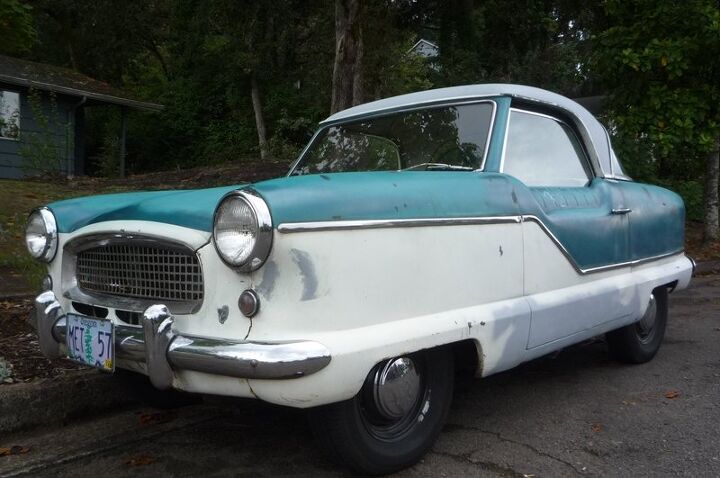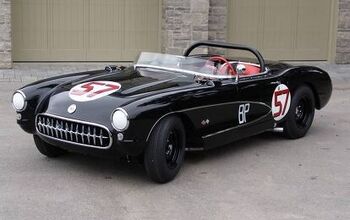Curbside Classic: 1957 Metropolitan

Americans generally just don’t take too well to tiny cars. Perhaps they’re too much like toys, not really yet grown up? The Metropolitan certainly looks the part, resembling an amusement park ride or clown car rather than a genuine automobile a self-respecting grown-up American would drive. And this particular Metro only reinforces that stereotype: it’s owner is fourteen, and he’s owned it since he was ten. “Dad, can I have this cool car?”
If you’re Russel, you’re in luck. He saw it sitting forlorn for years in a neighbor’s carport, and at the age of ten, he talked his dad into buying it for him. And who says kids aren’t into cars anymore? Just depends on the ride.
It’s not like Russel was exactly the target demographic Nash’s George Mason had in mind in the late forties, when he got the small car bug. A bit surprising too, coming on the heels of the failure of the tiny Crosley. Well, Mason initially had in mind something much more substantial than that little flea, and the result was the 1950 Rambler, the first “compact” of the post-war era.
Wisely, Nash positioned it is a “premium” compact, with a roll-back top and well equipped. There simply wasn’t enough difference in the cost of building a compact from a full-sized car to allow it to be sold for much less, so the Rambler broke new ground with an upscale approach. It worked well enough in moderate numbers to encourage Nash to go even a step smaller.
Designer Bill Flajole (above) was thinking along the same lines, and when he hoked up with Nash, their joint ideas on the subject were expressed in the NXI prototype of 1950. One of the key aspects of the design was to save money on large body stampings, since it was assumed the little car would not likely be a large volume job. Note the symmetrical door, which made it into the production Metro. To my knowledge, the fenders on the prototype were also symmetrical, except for the minor cutout for the front wheel. Symmetry as a way to reduce tooling costs was a recurring theme, especially at AMC, even into the sixties, when the prototype for the Hornet ( Cavalier) tried the same approach.
Mason was intrigued, but not enthusiastic about what it would take to actually produce it, profitably. The solution was outsourcing: with the devaluation of the British pound, having the Metro built in England made it viable. The firm Fisher & Ludlow, Ltd. built the body, and Austin supplied and installed the running gear, whose cars were already fairly common in the US as imports.
The 1954 Metro went on sale for about $1500 ($12k adjusted), pretty much the same as a Smart today. It used the popular 1500 cc B-block motor in 42 hp tune, and a three-speed with a column shifter. Given its light weight of some 1800 lbs, the Metro performed adequately, but then it was never positioned as a sports car. The suspension was tuned more for ride than handling. An MG in drag it was not.
Sales for the Metro were modest, bouncing around in the teens of thousands most of the years it was produced, from 1954 through 1960. The Big Three’s new compacts that final year put the kibosh on the Metro, but it’s had an enthusiastic following ever since, especially the young or young at heart.
My older brother (very much young at heart) went through a couple of these back in the late seventies, when they could be picked up for a song. His experiences keeping an MGA running years earlier came in handy, since they used the same basic motor and other BMC goodies and Lucas electrics. But their simplicity and availability of parts makes them a fun project, like for Russel and his dad.
The motor in this one is all original, and good to go. They’ve done some repair work to get the Metro back on the street, but like a good little CC, it is as original as possible, and shows it too. Russel has a lifetime of fun and improvements ahead of him. And, yes, he has put in some behind-the-wheel time in the Metro, despite his age, in undisclosed locations.
The Metro gets lots of attention, wherever it goes. Russell is looking forward to the Metro’s magnetic appeal to the opposite sex, just as soon as he can take advantage of it. Picking up girls with his dad along is a bit compromising, since that back “seat” is more than a bit cramped, even for limber young bodies.
The Metro found a modest following for a few years, as did the Crosley in the forties. And the Smart is going down that same road; in fact its sales are pretty much in Metro territory. But the euro is a lot stronger today than the pound was in 1954, so although Nash made a modest profit from the Metro, the same is not the case for the Smart. And of course, the little Crosley just didn’t catch on either. Toy cars, all of them. And they want to raise the driving age?
PS: atewithmotor has an excellent detailed history of the Metro, for those wanting a more serious look at it.

More by Paul Niedermeyer
Latest Car Reviews
Read moreLatest Product Reviews
Read moreRecent Comments
- Zipper69 A Mini should have 2 doors and 4 cylinders and tires the size of dinner plates.All else is puffery.
- Theflyersfan Just in time for the weekend!!! Usual suspects A: All EVs are evil golf carts, spewing nothing but virtue signaling about saving the earth, all the while hacking the limbs off of small kids in Africa, money losing pits of despair that no buyer would ever need and anyone that buys one is a raging moron with no brains and the automakers who make them want to go bankrupt.(Source: all of the comments on every EV article here posted over the years)Usual suspects B: All EVs are powered by unicorns and lollypops with no pollution, drive like dreams, all drivers don't mind stopping for hours on end, eating trays of fast food at every rest stop waiting for charges, save the world by using no gas and batteries are friendly to everyone, bugs included. Everyone should torch their ICE cars now and buy a Tesla or Bolt post haste.(Source: all of the comments on every EV article here posted over the years)Or those in the middle: Maybe one of these days, when the charging infrastructure is better, or there are more options that don't cost as much, one will be considered as part of a rational decision based on driving needs, purchasing costs environmental impact, total cost of ownership, and ease of charging.(Source: many on this site who don't jump on TTAC the split second an EV article appears and lives to trash everyone who is a fan of EVs.)
- The Oracle Some commenters have since passed away when this series got started.
- The Oracle Honda is generally conservative yet persistent, this will work in one form or fashion.
- Theflyersfan I love this car. I want this car. No digital crap, takes skill to drive, beat it up, keep on going.However, I just looked up the cost of transmission replacement:$16,999 before labor. That's the price for an OEM Mitsubishi SST. Wow. It's obvious from reading everything the seller has done, he has put a lot of time, energy, and love into this car, but it's understandable that $17,000 before labor, tax, and fees is a bridge too far. And no one wants to see this car end up in a junkyard. The last excellent Mitsubishi before telling Subaru that they give up. And the rear facing car seat in the back - it's not every day you see that in an Evo! Get the kid to daycare in record time! Comments are reading that the price is best offer. It's been a while since Tim put something up that had me really thinking about it, even something over 1,000 miles away. But I've loved the Evo for a long time... And if you're going to scratch out the front plate image, you might want to do the rear one as well!













































Comments
Join the conversation
One of my grandparents worked for Nash when this came out. I always wished he had bought one and hung on to it for sentimental reasons. But of course for him it was probably just another car he worked on, and the cheapest, smallest one in the line at that. They only owned one car as the family car since he always drove fleet cars to and from work (often some weird foreign subcompact from the research pool according to Mom). A Met would not have made a good family car and a second car "just for fun" would have caused the Frugal Scot portion of his blood to reject his brain as an organ. Actually what he usually ended up buying was a wagon - Airflytes, Classics, Ambassadors, and his final AMC - a 1977 Firecracker Red Pacer wagon (yes, with basketry print upholstery and woodgrain accents). Wouldn't mind having any one of those either. When I was a kid he had an early '70s Ambassador he called "The Big Yellah Car" that was pretty cool. Instead, when he died he left behind a [nod]off-white, Arizona-garaged, low mile, 1st generation Chevrolet Cavalier wagon with few options, blown struts, and no brakes. Yeah... nobody fought over that after the funeral.
My Metro, which, by the way, was the same color as the one above, had a strange thump from the driver's door when going around corners. I finally pulled off the inner door panel and found a heavy steel backing block that a worker would use to pound out steel. Some assembler in England probably wondered where his tool had disappeared to. It was obvious that some "southern engineering" was needed to make parts fit. I still have the block in my workshop today, almost 60 years later.